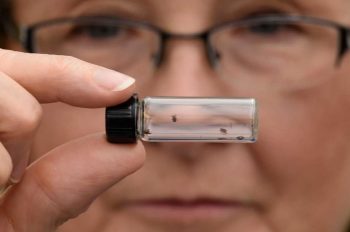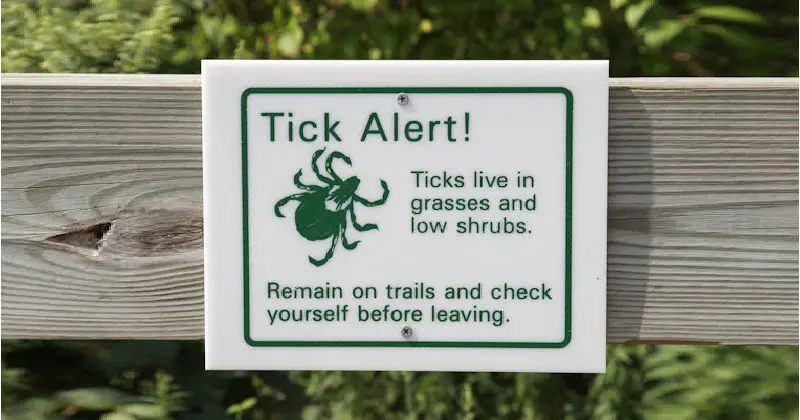April 14th, 2017
Contributing writer for Wake Up World
National surveillance of Lyme disease statistics began in 1982 and since then the number of reported cases has grown over 25-fold.1 Between 1990 and 2015, the number of reported cases in the U.S. doubled.2 Each year approximately 30,000 cases of Lyme disease are reported to the CDC.6 However, this number does not reflect all cases diagnosed in the U.S. Following two studies by the CDC, researchers estimate 10 times that number are infected with Lyme disease each year, for a total ranging between 296,000 and 376,000 cases. According to the Centers for Disease Control and Prevention (CDC), it’s the fastest growing vector-borne infectious disease in the U.S.4
The disease has also spread geographically.3 The CDC reports the disease, and the ticks that carry the disease, are concentrated in the northeast and upper Midwest.5 And ticks carry more than just Lyme disease, but also Rocky Mountain spotted fever and human babesiosis, a rare microscopic parasite that infects red blood cells.
What Lyme Disease Is and How It’s Spread
Lyme disease is a bacterial infection primarily transmitted by ticks that have previously fed on an infected host. However, some top authorities on Lyme disease, like Dr. Dietrich Klinghardt, warn the bacteria that cause the disease may also be spread by other insects such as fleas, mosquitoes, mites and spiders.
Lyme disease remains one of the most serious and controversial epidemics today. Lyme disease is often called “the great imitator,”7 as it may mimic a number of other disorders, such as arthritis, chronic fatigue syndrome, multiple sclerosis (MS), amyotrophic lateral sclerosis (ALS) and Alzheimer’s disease. Outwardly, most infected individuals appear healthy, in spite of suffering severe symptoms. Vague and dispersed pain complaints may be misdiagnosed as fibromyalgia.
The disease usually starts with fatigue, fever, headaches and joint or muscle pain. It can then progress to muscle spasms, loss of motor coordination, intermittent paralysis, meningitis and even heart problems. Lyme disease was named after the east coast town of Lyme, Connecticut, where the illness was first identified in 1975. It wasn’t until 1982 that Willy Burgdorfer, Ph.D., discovered the bacteria responsible for the infection — a cousin to the spirochete that causes syphilis. They look almost identical under a microscope.
Burgdorfer named the bacteria Borrelia burgdorferi. The corkscrew shape allows the bacteria to hide in a variety of different body tissues, causing a wide range of symptoms. The bacteria may also live inside your cells in an “L-form” or coated as a cyst. The ability to change forms is one of the reasons diagnosis and treatment is so challenging, and why recurrence of symptoms may result after standard antibiotic protocols.
Ticks are not born with the bacteria but acquire it after feeding on a host. White-footed mice, which are a common carrier, infect an estimated 75 to 95 percent of larval ticks that feed on them. Urban sprawl and reduction in natural predators have allowed the mouse population to quickly multiply, and with them the infected ticks. The growing number of infections are therefore not surprising — but how the medical community responds will determine the extent of the damage this disease may cause in the coming years.
Today, although chronic Lyme disease is more widely recognized as an actual disease, there continues to be resistance in the medical community and with insurers. Sufferers are often told the problem is psychiatric.
Early Spring is Creating the Perfect Lyme Storm
According to data from the U.S. Geological Survey, spring arrive three weeks early this year for nearly half of the U.S.8 If you love being outside without layers of clothing, this may sound like a good thing. However, the warm weather also poses public health challenges.
The majority of time Lyme disease is spread through tick bites, however it can also be spread by mosquitoes, spiders, fleas and mites — and an early spring may effect the spread of those insects that spread disease. Dr. Aaron Bernstein, associate director of the Harvard T. H. Chan School of Public Health Center, commented on the spread of disease, and diseases for which no good treatment is currently available:9
“There’s no question that when it’s too cold, ticks and mosquitoes cannot thrive. An overall warming trend opens up the chance for them to live in new places and to stay alive for longer periods of time.”
The combination of higher risks of flooding with an early spring, milder temperatures, growing populations of ticks and Lyme infected mice, and more people being more active outdoors, may amplify the spread of Lyme disease, increasing the number of people infected over time.
Interestingly, the ticks do not get sick from the bacteria they carry. Joao Pedra, Ph.D., studies microbiology and immunology at the University of Maryland School of Medicine. He wanted to know what was happening in the ticks’ immune system and found several genes necessary for mosquito immunity was absent in ticks.10 Instead of identifying a foreign invader by sugar molecules, a tick’s immunity identifies lipid molecules, making them uniquely adapted to handle a bacteria that uses lipids to keep the cell structure intact. Pedra speculates the bacteria may also enable ticks to live through cold weather.
Areas Affected by Lyme Disease in the United States are Growing
Areas of the U.S. affected by Lyme disease are growing, and most notably in the coldest, more northern states. The CDC estimates the two states to be hardest hit by Lyme disease this season are New Jersey and Pennsylvania.11 Researchers in New York have also found the regional mouse population is exploding.
Lyme disease is not exclusive to the eastern U.S., but also has a presence in Wisconsin and Minnesota. However, in recent years the tick population has spread to Michigan, in both the Upper and Lower Peninsulas.
The number of diagnosed cases increased five times over a four-year study period, indicating an expanding geographic distribution northward.12
The increasing number of people diagnosed with Lyme disease may be, in part, the result of better diagnosis and an increasing number of physicians who suspect Lyme disease as the cause of their patients’ symptoms. It may also be attributed to an increasing number of people who are moving to suburban areas that are being reforested.13
Also see: Lyme Disease on the Rise as Tick Epidemic Spreads Across the U.S.
Although the number of areas affected by Lyme disease is growing, another challenge is convincing people the threat of this condition is real. According to a survey of more than 11,000 people done by the CDC between 2009 and 2012, 21 percent of households had one person bitten by a tick in the past year,14 but only 10 percent of those reported seeing a health professional. Over 50 percent of the respondents to the survey reported they did not take any precautionary or preventive measures during warm weather. Overall, the survey found that exposure to ticks was common and an awareness of Lyme disease was widespread, but preventive methods were used infrequently. This may indicate a poor understanding of the secondary effects of chronic Lyme disease, or a belief that the respondents simply would not contract the disease.
Symptoms of Lyme Disease May Baffle Your Physician
In the video above, U.S. Congressman for New Jersey’s 4th District, Chris Smith, describes the challenges patients are facing in the recognition and treatment of Lyme disease.
People with Lyme disease are often described as “looking good” and their blood work often comes back normal, making diagnosis of the acute and chronic condition challenging. In fact, the Infectious Disease Society of America (IDSA) doesn’t believe there is a chronic condition, stating symptoms should be gone in two to four weeks after antibiotic treatment.15 As a result, many patients are referred to a psychiatrist and some doctors have gone so far as to accuse patients of being attention seekers fabricating their symptoms.
Also see: Chronic Lyme Disease: A Modern Plague the US Government Chooses to Ignore
A significant contributing challenge is the disease is notoriously difficult to diagnose using lab testing. The bacteria is able to infect your white blood cells. Testing measures the antibodies white cells produce, but infected cells don’t respond appropriately. Antibodies to the disease appear only after your white cells are functioning normally. This means that to get an accurate blood test, you first have to undergo treatment.16 To overcome this challenge, the CDC recommends a two-step testing process.17
IGeneX lab, which specializes in Lyme testing, has a potentially more accurate test. They are accredited by the Centers for Medicare and Medicaid Services and hold licensure in several states. Their test is highly specific for bacterial strains and co-infections. They check for bacterial DNA, ideal for people who do not produce antibodies to Lyme disease.18,19
Posing another significant challenge, there is great variation in presenting symptoms and the characteristic “bulls-eye” rash is not present in nearly half of patients. The difficulty in diagnosis has led to resistance in acknowledging both the acute and chronic phase of the disease. This occurs in patients who are medical professionals as well.
Dr. Neil Spector, oncologist at Duke University, recounts his journey with Lyme disease in his autobiographical book, “Gone in a Heartbeat: A Physician’s Search for True Healing.”20 Spector’s doctors attributed his symptoms to stress as his blood work was negative, until severe heart failure required a transplant. He commented:21
“Heaven help the patient whose diagnostic tests do not point to a specific disease. They are likely to end up neglected by the very system that was designed to help them … despite my instincts and research into the field, I was largely being discounted by the medical community. If this can happen to a physician-scientist with extensive knowledge of medicine, just imagine what is happening to others who lack a medical background.”
It’s Important to Take Prevention Seriously.
The treatment for Lyme disease is challenging and often controversial, making prevention vital. Many people are unaware of environments that ticks like to inhabit, or how they behave. Young ticks (the size of a poppy seed) may crawl over your shoes and up your pants; adult ticks are more likely to drop from trees or crawl under an untucked shirt.22
If you live or travel through a high-risk area, maintain your guard against tick bites. Here are several ways you can prevent contracting Lyme disease:23,24,25
| Avoid tick-infested areas, such as leaf piles around trees. Walk in the middle of trails and avoid brushing against long grasses. Don’t sit on logs, wooden stumps, stonewalls or the ground. | Ticks are very tiny. You want to find and remove them before they bite, so do a thorough tick check upon returning inside and take a shower.
Continue to check your body and bedding for several days after being in an area likely to have ticks. |
| Considering the high infection rate of rats, you’d be wise to take precautions if you’re in an area where rats have been sighted. | Tuck your pants into socks and wear closed shoes and a hat, especially if venturing out into wooded areas. Also tuck your shirt into your pants. |
| Wear light-colored long pants and long sleeves with a tight weave, to make it easier to see the ticks. | Once you return home, place your clothing in the dryer (before washing) on high heat for 60 minutes to kill any ticks on your clothes. |
| Your pet can become a host for ticks and may also become infected with Lyme disease, although it is more likely they will test positive but won’t experience symptoms. | I don’t recommend using chemical repellents directly on your skin as this introduces toxins directly into your body. If you choose to use them, spray the outside of your clothes while outside and avoid inhaling the fumes. |
| Keep long hair tied back, especially when you are gardening. Remove leaves from your lawn each fall, as ticks will seek shelter from cold weather and snow under piles of leaves. | If you find that a tick has latched onto you, it’s very important to remove it properly. For detailed instructions, please see lymedisease.org’s tick removal page.26
Once removed, make sure you save the tick so that it can be tested for presence of pathogenic organisms. |
Antibiotics are NOT the Best Treatment Option
While early treatment is critical to prevent complications, traditional treatment involving a course of antibiotics is often unsuccessful in preventing complications, including arthritis, cognitive deficits, heart rhythm irregularities or neurological symptoms.27 Antibiotics damage your gut microbiome and increase your risk of yeast and fungal infections. For these reasons, it is advisable to exhaust natural strategies to help your body fight Lyme disease.
One example is the Nutramedix line of herbal antimicrobials, recommended by one of the most prominent alternative medicine experts, Dr. Lee Cowden. The reason this natural treatment has been so effective for treating Lyme disease is that it rotates a variety of herbal antimicrobials, so bacteria does not develop a resistance to any one intervention.
Also see: Stevia Kills Lyme Disease Pathogen Better Than Antibiotics (Preclinical Study)
To help your body fight the infection, you should consume a nutritious diet rich in antioxidants. You can also take antioxidants and other supplements, to help your body fight the infection and relieve symptoms. Here are some supplement recommendations if you are embracing a natural treatment approach:
| Astaxanthin: neutralizes toxins and relieves joint pain | Probiotics: optimizes gut flora and supports immunity |
| Grapefruit seed extract: may help treat Borrelia in cyst form | Cilantro: a natural chelator for heavy metals |
| Krill oil: helps in reducing inflammation and relieving Lyme symptoms | Resveratrol: helps with detoxification and it may treat the common co-infection, Bartonella |
| Quercetin: reduces histamine, which is usually high in Lyme patients | Whey protein concentrate: may help with nutrition, a common problem in Lyme patients who are unable to eat properly |
| Andrographis and Artemisinin: herbs that treat the common co-infection, Babesia | Curcumin: helps reduce brain swelling and eliminates neurological toxins |
| GABA and melatonin: addresses insomnia, which is common in people with Lyme disease | CoQ10: supports cardiac health, alleviates muscle pain and reduces brain fog |
| Transfer factors: helps boost immune function |
Dr. Dietrich Klinghardt is one of the top authorities on Lyme disease. He has a Lyme disease protocol that can help you recover from the infection. His website explains the protocol in detail, but here are the basic steps to give you an idea of what it entails:28
- Evaluate all external factors, and address as appropriate. These include molds, electromagnetic fields, electrosmog and microwave radiation in connection to wireless technologies. Klinghardt advises shielding your home using Y shield (special graphite paint) in order to reduce microwave radiation coming from the outside. Cloth coated with silver is used for curtains. Patients are advised to turn off all fuses at night and eliminate all cordless telephones until they recover from the illness.
- Address stress and emotional issues. Energy psychology tools like the Emotional Freedom Techniques can be helpful to address the emotional components of Lyme.
- Address parasitic, bacterial and viral infections. Parasites need to be addressed first, followed by bacteria and then viruses. Klinghardt uses an antimicrobial cocktail composed of wormwood, vitamin C, phospholipids and different herbs. Viral infections are addressed with BioPure’s Viressence, a tincture of Native American herbs.
- Address other lifestyle factors. Determine your need for supplementation (antioxidants) to address nutritional deficiencies.
Additional Resources:
- International Lyme and Associated Disease Society (ILADS)
- Tick-Borne Disease Alliance (TBDA). Under the “Diagnosing TBDS” tab, you can find a listing of medical professionals knowledgeable in the treatment of Lyme
- Lyme Disease Association, Inc.
- LymeDisease.org
- Lyme disease expert Dr. Joseph J. Burrascano wrote what is essentially a manual for managing Lyme disease, “Advanced Topics in Lyme Disease”, which is worth adding to your resources. However, beware that his treatment focus is long-term antibiotics, which I believe should not be your first choice. Nevertheless, there is some good information there.
- 1, 4 International Lyme and Associated Diseases Society, ILADS About Lyme
- 2 United States Environmental Protection Agency, Climate Change Indicators: Lyme Disease
- 3 NBC July 15, 2015
- 5 Centers for Disease Control and Prevention, Lyme Stats
- 6 Centers for Disease Control and Prevention, How Many People Get Lyme Disease?
- 7 Symbiosis 2009
- 8 U.S. Geological Survey, Watch the Unusually Early Advance of Spring 2017
- 9 Time Magazine, February 27, 2017
- 10 Newsweek, February 14, 2017
- 11 New Jersey 101.5, March 8, 2017
- 12 Oxford Academic, February 10, 2017 Geographic Expansion of Lyme Disease in Michigan, 2000–2014
- 13 DailyBurn, February 11, 2015
- 14 Ticks and Tick-Borne Diseases 2015; 6(4):483
- 15 Infectious Disease Society, ISDA Guidelines Lyme Disease
- 16 MayoClinic, Lyme Disease
- 17 Centers for Disease Control and Prevention, Two Step Laboratory Process
- 18 IGeneX
- 19 LymeAidUK, Get a Test
- 20, 21 Forbes, September 4, 2015
- 22 Baltimore Sun
- 23 New York State Department of Health
- 24 WZZM13, February 24, 2017
- 25 NPR, March 6, 2017
- 26 LymeDisease.org, Tick Removal
- 27 MayoClinic, Lyme Disease Complications
- 28 Klinghardt Academy, Protocols
About the author:
 Born and raised in the inner city of Chicago, IL, Dr. Joseph Mercola is an osteopathic physician trained in both traditional and natural medicine. Board-certified in family medicine, Dr. Mercola served as the chairman of the family medicine department at St. Alexius Medical Center for five years, and in 2012 was granted fellowship status by the American College of Nutrition (ACN).
Born and raised in the inner city of Chicago, IL, Dr. Joseph Mercola is an osteopathic physician trained in both traditional and natural medicine. Board-certified in family medicine, Dr. Mercola served as the chairman of the family medicine department at St. Alexius Medical Center for five years, and in 2012 was granted fellowship status by the American College of Nutrition (ACN).
While in practice in the late 80s, Dr. Mercola realized the drugs he was prescribing to chronically ill patients were not working. By the early 90s, he began exploring the world of natural medicine, and soon changed the way he practiced medicine.
In 1997 Dr. Mercola founded Mercola.com, which is now routinely among the top 10 health sites on the internet. His passion is to transform the traditional medical paradigm in the United States. “The existing medical establishment is responsible for killing and permanently injuring millions of Americans… You want practical health solutions without the hype, and that’s what I offer.”
Visit Mercola.com for more information, or read Dr. Mercola’s full bio and résumé here.
Recommended articles by Dr. Joseph Mercola:
- How LED Lighting May Compromise Your Health
- Essential Oils Can Help Ease Symptoms of ADHD
- Medical Errors: Still the Third Leading Cause of Death
- Plants Are Smarter Than You Think
- Photobiology: How Therapeutic Use of Full-Spectrum Light Can Improve Your Health
- Scientific Links Between Processed Foods and Depression
- How Sugar Harms Your Brain Health and Drives Alzheimer’s Epidemic
- The Health Benefits of Intermittent Fasting
- Can a Hug a Day Keep Infection Away?
- The Magic Healing Power of Mushrooms
- Battered Bees and the Threat to Our Food Supply
- The Science of Healing Thoughts
- Life Expectancy Projected to Soar — Except in the U.S.
- Evidence EPA Colluded with Monsanto to Cover-Up Glyphosate/Cancer Link

If you've found value in our articles, we invite you to support the release of our brand-new book, "Gratitude Practices for Kids: A Practical Guide for Adults to Instill a Spirit of Appreciation and Positivity in the Next Generation."
"Gratitude Practices for Kids" brings together over 25 innovative and accessible practices designed to enhance gratitude in everyday life. This comprehensive guide is backed by 17 scientific studies, ensuring each concept is grounded in research, underscoring our commitment to nurturing growth, emotional intelligence, and positive interactions between adults and children.
We encourage you to opt for the paperback version to celebrate this new release. Dive into its fresh pages away from digital distractions, allowing you to immerse yourself in the transformative practices it offers.
Over recent years, Wake Up World has faced significant online censorship, which has impacted our financial ability to operate. Moving into book publishing represents a strategic step to secure the ongoing funds needed to continue our mission. By purchasing Gratitude for Kids, you help us keep our content free and accessible to everyone, avoiding needing a paywall. With over 8,500 articles published in the last 13 years, we remain dedicated to keeping our valuable content open to all.










